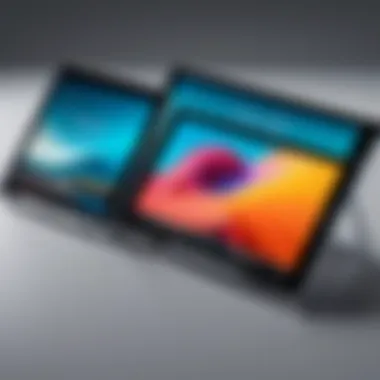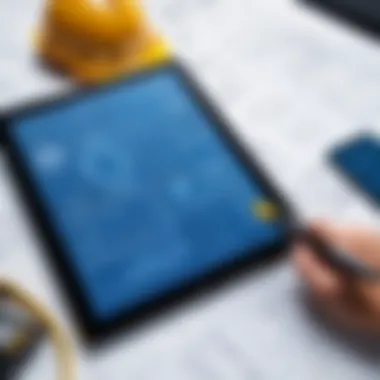Choosing the Ideal Tablets for Construction Drawings


Intro
Choosing the right tablet for construction drawings isn’t just about convenience; it can significantly influence productivity and accuracy on site. The landscape of construction is evolving, and having the right tools to interpret complex designs is paramount. From the early phases of project visualization to detailed onsite measurements, the proper tablet can make all the difference. As we dive into this guide, we'll consider the vital factors that differentiate average tablets from the ideal ones tailored for professionals in construction.
In the following sections, we will blend practical insights with an analytical look at key features, comparing leading models to highlight their supremacy in this specialized market. Let’s plunge into the nitty-gritty of software capabilities, which play a crucial role in maximizing the efficacy of these devices in construction environments.
Understanding the Role of Tablets in Construction
In the fast-paced world of construction, the tools that teams use can make a significant difference in project outcomes. Tablets are becoming essential devices on construction sites. They represent a shift towards digital solutions, offering an array of benefits that not only keep projects on track but also enhance the quality of work.
Identifying the role of tablets in this field leads to a deeper understanding of how this technology harmonizes with design and execution stages. The transition from traditional paper blueprints to digital means is not just a trend; it’s a necessity to maintain efficiency and precision. As the construction industry embraces these devices, the relevance of understanding their beneficial aspects becomes increasingly clear.
The Shift from Paper to Digital
Gone are the days when drafts and drawings were exclusively on paper. The construction industry has gradually adopted digital formats, primarily due to the ease of access and modifications. Tablets offer construction professionals the ability to carry entire portfolios of work on a single, portable device. This shift facilitates instant updates to project plans, allowing workers to access the latest information right from the job site. There’s less chance of errors now that everyone can refer to the most current drafts, reducing costly mistakes and delays.
Benefits of Using Tablets
The integration of tablets in construction presents several key advantages:
- Portability and Flexibility: Construction sites are dynamic environments. Employees are often moving from one area to another, whether surveying, collaborating, or discussing plans. Tablets allow for quick access to documents without being tied down to a desk. One can easily pull up measurements, specifications, or site plans from virtually anywhere.
- Enhanced Collaboration: Teamwork is a cornerstone of construction. Tablets improve communication and collaboration by enabling real-time updates. Multiple stakeholders can view the same document simultaneously, reducing the back-and-forth that often leads to miscommunication. One unique aspect of this collaboration is the ability to annotate and share changes directly on the drawing, which streamlines feedback and updates between architects, engineers, and site managers.
- Access to Digital Resources: The construction industry is inundated with digital tools and applications designed to aid project management and execution. Tablets can run these applications, providing seamless access to resources like BIM (Building Information Modeling) and CAD (Computer-Aided Design). This access allows professionals to utilize a wide range of materials, templates, and tools that enhance the functionality of traditional blueprints.
In summary, understanding how tablets fit into construction roles allows professionals to leverage their capabilities effectively. The shift from paper to digital, combined with portability, collaborative tools, and access to essential resources not only enhances workflow efficiency but ensures that teams stay aligned with the project requirements, ultimately leading to successful outcomes.
Key Features to Look for in a Construction Tablet
When it comes to selecting a tablet specifically tailored for construction drawings, not all tablets are created equal. Professionals in this field require devices that can withstand the rigors of a job site while delivering clear, detailed images of plans and blueprints. Therefore, understanding the key features that qualify a tablet for construction work is paramount. This ensures that whether you are on-site or in the office, your device will meet the needs of your work seamlessly.
Display Quality and Size
Importance of Resolution
Resolution is one of those critical aspects that can’t be overlooked when assessing a tablet’s display capabilities. In the world of construction drawings, where minute details matter, having a high-resolution display makes a world of difference. A screen with a resolution of at least 1920x1080 pixels typically offers crisp lines and vivid colors, allowing users to clearly see intricate design elements and read fine text.
For example, when zooming into a complex plan, having a higher pixel density ensures that the details remain sharp and do not blur, which can often lead to misinterpretations. A tablet boasting a Retina display or its equivalent is often favored because it provides a brighter and more vibrant viewing experience, enhancing the clarity of technical drawings.
Optimal Screen Size for Drawing
In discussing the right screen size for construction drawings, context is crucial. A larger screen, generally in the range of 10 to 12 inches, provides ample real estate for multitasking and viewing detailed designs side-by-side. It ultimately allows users to work more efficiently, freeing them from the need to constantly zoom in and out.
However, it’s worth noting that while bigger screens can be more comfortable for detailed work, they may also be bulkier to carry around. Therefore, professionals often need to find a balance between size and portability, depending on their typical workflow and job site conditions.
Battery Life Essentials
When working on-site, the last thing you want is for your tablet to run out of juice. A tablet that promises a minimum of 8 to 10 hours of battery life is generally considered acceptable in the construction field. It ensures you can be out in the field without scrambling for a power outlet. Moreover, modern tablets now feature quick-charge capabilities that can provide a substantial battery boost in a short amount of time, which adds a layer of convenience.
Processing Power and Performance
Understanding RAM Requirements
Enough RAM is essential to handle software applications that might be running concurrently, especially in scenarios where multitasking becomes necessary. A tablet equipped with at least 4GB of RAM can run construction a-specific apps without lagging, which is pivotal when quick access to documents and blueprints is required.


Moreover, for those who might also engage in heavier tasks, such as 3D modeling, considering a device with 8GB or more will facilitate a smoother experience. It essentially prevents any frustrating delays that could arise from resource-constrained environments.
CPU Specifications for Smooth Operation
The CPU, or the brain of the tablet, plays a significant role in its overall performance. Look for tablets featuring processors that can handle demanding tasks with grace. A quad-core processor is often a popular choice because it can quickly execute concurrent processes—ideal for running multiple apps or handling complex software.
Choosing a tablet with such specifications not only guarantees that documents load swiftly but also enhances responsiveness, especially during intricate tasks like drawing adjustments or edits.
Durability and Build Quality
Importance of Water and Dust Resistance
In the construction environment, tablets do not just sit on a desk. They are exposed to dust, debris, and occasionally, unfortunate splashes of water. Therefore, a tablet with a solid rating in water and dust resistance—such as an IP67 rating—becomes essential. This feature provides peace of mind knowing that your device can withstand job site conditions.
Rugged vs. Standard Tablets
Choosing between rugged and standard tablets ultimately boils down to the specific use case. Rugged tablets are built to endure tough conditions, boasting heavy-duty materials designed to resist impacts. For construction professionals whose work takes them into rougher territory, such devices provide extra assurance.
Conversely, standard tablets might be sufficient for those mainly operating in office environments or only occasionally visiting job sites. They are typically lighter and more cost-effective, but lack the durability to survive drops or extreme conditions. Combined with features like drop protection and reinforced screens, every aspect is geared towards ensuring long-lasting functionality in demanding settings.
Popular Tablets for Construction Drawings
In the realm of construction, every precision counts. As projects become more intricate and demands for efficiency grow, having the right tool at your fingertips can significantly impact workflows. Tablets have become indispensable assets on construction sites, serving not just as digital planners, but as platforms for real-time collaboration and design refinement. What makes a tablet stand out, however? In this segment, we’ll explore some leading models that cater specifically to the needs of construction professionals.
Comparative Review of Leading Models
While many tablets flood the market, not all are equal in terms of performance or adaptability to construction drawings. Key factors such as display quality, processing capabilities, and robust software compatibility dictate efficiency on the job. A focused review of specific models helps identify the best options tailored for construction tasks. Such insights can save time, providing ground-level professionals with tools adept at surviving the rigors of the field. Let’s delve into four standout tablets that have carved their niche in the construction landscape.
Apple iPad Pro
Specifications and Features
The Apple iPad Pro has emerged as a top choice among construction workers. Its high-resolution Liquid Retina display offers crystal-clear visuals that make identifying minute details on plans seamless. Mid its specifications, the advanced M1 chip ensures lightning-fast responsiveness, crucial for multitasking. One distinct characteristic is the use of ProMotion technology, providing smoother scrolling and enhanced touch sensitivity. Such features not only improve drawing accuracy but also make on-the-go adjustments simpler without the lag that can frustrate users.
Pros and Cons for Construction Use
The iPad Pro does come with its perks and pitfalls. A primary advantage is its versatile app ecosystem, which includes dedicated construction software that optimally utilizes its features. However, the price point might deter some—it's on the pricier side of the spectrum. Additionally, its design is sleek but can be less rugged compared to more durable models. This consideration may influence the choice for users who prioritize sturdiness over aesthetics.
Microsoft Surface Pro
Specifications and Features
The Microsoft Surface Pro stands out with its detachable keyboard and full Windows operating system, resembling a laptop's functionality yet offering the portability of a tablet. Its display is both vivid and adjustable, allowing users to tweak settings for outdoor visibility. Notably, the Surface Pen ensures precision when marking up designs or making notes—an essential that professionals value particularly during client meetings or site inspections.
Pros and Cons for Construction Use
While the versatility is a huge win, it’s not without downsides. On the plus side, the compatibility with Windows software means compatibility with industry-standard programs. But, it can be heavier than other offerings, thus reducing mobility. Additionally, the battery life, while decent, may require an occasional midday charge—something to keep in mind for longer site visits.
Samsung Galaxy Tab S Series
Specifications and Features


The Samsung Galaxy Tab S Series offers a vibrant AMOLED display which brings construction drawings to life, showcasing colors in their truest form. With an IP68 rating, it provides solid water and dust resistance, making it a strong contender for unpredictable job sites. Moreover, S Pen functionality lets users doodle and draw with a level of accuracy that can drive project adjustments efficiently.
Pros and Cons for Construction Use
This tablet impresses with its durability and display quality. Plus, it integrates easily with Samsung's DeX mode, allowing for a desktop-like experience when docked. On the flip side, while the software selection is substantial, some construction-specific applications may not be as robust as those found on the iPad or Surface tablet, leading to some friction in user experience.
Lenovo Tab Series
Specifications and Features
The Lenovo Tab Series appeals to budget-conscious buyers without skimping on essential features. Designed for robust usage, it often comes with long-lasting battery life—ideal for long days away from a charger. The display, while not as pristine as its competitors, still delivers a satisfactory performance for basic drawing and annotation tasks.
Pros and Cons for Construction Use
The primary draw is cost-effectiveness, offering necessary tools at a fraction of the price of high-end counterparts. That being said, less powerful hardware may not handle intensive applications smoothly, which could hinder productivity in complex projects. Also, the build quality is more fragile compared to its rugged competitors, essential factors to reckon when making a choice.
Software Compatibility and Tools for Construction Drawings
When navigating the landscape of modern construction, the tools at your disposal can shape the way you work. Tablets have turned into essential devices for those in the construction industry, particularly for handling complex drawings and schematics. However, the sheer range of software options available today can be a double-edged sword. That's where software compatibility comes into play. With the right apps, you can transform a simple tablet into a powerful tool that supports your workflow and amplifies productivity.
Essential Apps for Construction Professionals
The effectiveness of a tablet in a construction setting largely hinges on the applications it can run. There are key apps known to streamline processes, enhance project management, and improve collaboration among teams.
For instance, Autodesk AutoCAD is widely recognized for its robust capabilities in drafting and design. Similarly, Bluebeam Revu stands out for its PDF editing features, tailored for construction professionals. These apps not only allow for precision in layouts but also facilitate critical communication among stakeholders.
Furthermore, many popular project management tools like Procore and Trello offer mobile compatibility. This brings the advantage of real-time updates and task assignment, which is crucial on-site where conditions may change rapidly.
File Formats and Accessibility
Supported Formats for Drawings
Understanding what file formats your drawing software can handle is pivotal. Typically, formats like DWG, PDF, and DWF are industry standards. Being able to access and manipulate these formats seamlessly can save considerable time and reduce errors.
Tablet users often benefit from the versatility of working with PDFs for presentations while maintaining the detailed and layered information available in DWG files. Each format has unique characteristics; for instance, PDF files are easier to share and review, but DWG files retain all the information needed to edit or modify designs.
A major draw of supporting multiple formats is the flexibility it offers. If a contractor receives a drawing in a format they cannot use, their productivity stalls. Tablets that support a range of file types remove this barrier, making them invaluable.
Integration with Other Software Tools
Integration capabilities with other software tools is another crucial aspect to consider. Tablets that can seamlessly connect with project management systems, cloud storage, or BIM software set themselves apart. This integration enhances efficiency; teams can share files on platforms like Dropbox or Google Drive instantly.
For instance, if you're using a tablet with BIM software like Revit, the ability to push updates directly to other applications results in smoother workflows. The risk of errors diminishes too, as one central source of truth is maintained. Integrating these tools may come with challenges, like compatibility issues, but when done right, the benefits clearly outweigh the cons.
"Choosing a tablet that supports essential apps and file formats is not just a matter of convenience; it can markedly improve the quality of your work and your team's communication."
To summarize, software compatibility and the tools available can dramatically influence how well a tablet serves construction professionals. A well-chosen device can foster better collaboration, streamline processes, and lay the groundwork for a more efficient workflow in the challenging environment of construction.
Best Practices for Using Tablets in Construction Settings
In the realm of construction, the effective use of tablets can significantly enhance productivity and accuracy. Understanding best practices when using these devices helps address the unique challenges faced on-site. By focusing on how to utilize tablets efficiently, construction professionals can not only improve workflow but also safeguard their data and extend the lifespan of their devices. This section outlines critical best practices that should be adopted for optimal tablet use in construction settings.


Optimizing Screen Usage
One key aspect of getting the most out of a tablet in a construction environment is optimizing screen usage. Construction sites are often bustling with activity, and ensuring that the display settings are tailor-fitted can make a world of difference.
- Brightness Levels: Adjusting the brightness is crucial. Too low, and it’s hard to read the plans; too high, and it drains the battery. A balanced brightness setting can enhance readability and conserve energy.
- Screen Orientation: Depending on the activity, switching between landscape and portrait modes can make reviewing designs more convenient. This small adjustment helps adapt the display to suit the task at hand—be it reading detailed drawings or marking possible issues.
- Gesture Controls: Taking advantage of gesture controls can facilitate smoother navigation, allowing users to zoom in and out efficiently without fumbling through multiple taps.
"A little tweak here and a little adjustment there can feel like night and day in terms of usability."
Maintaining Device Security
In construction, protecting information is paramount. Maintaining robust device security safeguards data integrity and avoids costly breaches. Here’s an overview of recommended practices.
Data Protection Strategies
Data protection is vital, especially given the sensitivity of construction documents and drawings. Implementing strong strategies ensures that valuable information remains safe.
- Regular Backups: Frequent backups prevent data loss from unforeseen circumstances like device malfunctions. Utilizing cloud storage options keeps information secure and accessible.
- Encryption: Encrypting sensitive files makes them unreadable to unauthorized users, adding an extra layer of protection. This proactive measure is incredibly important when dealing with client specifications and proprietary designs.
- Password Management: Encouraging complex passwords strengthens device security. Multifactor authentication adds further protection, ensuring only authorized personnel can access crucial data.
The importance of these strategies can't be overstated; safeguarding information means protecting a project's integrity and the business’s reputation.
Choosing Appropriate Security Software
Selecting the right security software is also integral. Not all software solutions are created equal, and finding one that suits the specific needs of construction projects can be a game changer.
- Antivirus Software: Reliable antivirus solutions help guard against malware and cyber threats. This is especially critical on job sites, where unsecured Wi-Fi networks may be in use.
- Firewall Protection: Activating firewalls is a straightforward way to block unauthorized access to the device. Effectively managing this security feature can deter potential risks, keeping sensitive data safe.
- Software Updates: Staying updated not only enhances security but also ensures that your device runs optimally. Outdated software can have vulnerabilities that are exploited by malicious actors.
These choices affect overall security, and investing time in selecting the appropriate software can have beneficial long-term effects on the safety of construction projects.
Routine Maintenance for Longevity
Routine maintenance is often neglected despite being critical for extending the life of a tablet. Simple practices can maintain functionality and upgrade performance.
- Cleaning: Regular cleaning of the screen and ports prevents dust and grime from accumulating, reducing equipment issues.
- Battery Care: Monitoring battery life and keeping the device charged can prevent unexpected shutdowns on the job. Avoiding extreme temperature conditions also helps maintain battery performance.
- Software Clean-Up: Keeping the storage free from unnecessary apps and files aids in smoother operation. Deleting unused applications not only saves space but also reduces clutter.
Incorporating these practices helps construction tablets remain reliable tools that can withstand the demands of a fast-paced work environment.
Finale: Making an Informed Decision
Making the right choice when it comes to selecting a tablet for construction drawings is not an endeavor to be taken lightly. The stakes are high; these devices are not just accessories, they’re integral tools that can enhance productivity and accuracy on site. When weighing options, it’s crucial to consider various factors that directly impact usability, compatibility, and overall performance in a construction environment. As has been discussed throughout this article, the elements of display quality, processing power, and durability should form the backbone of your decision-making process.
This decision has deeper implications than simple preference. Entering the digital age means often tossing aside traditional methods and embracing a more efficient workflow. These tablets are designed to meet real needs and demands of modern construction aerials. Most importantly, choosing wisely will translate into reduced errors and improved collaboration among teams.
"The right tools can make all the difference, transforming a daunting task into a manageable project."
Recap of Key Considerations
To recap, there are several key considerations that should be on your radar:
- Display Quality and Size: A high-resolution screen is vital for detailing drawings accurately.
- Battery Life Essentials: Long battery life ensures work can continue uninterrupted, especially on busy job sites.
- Processing Power and Performance: Adequate processing capabilities help in running complex software without lag.
- Durability and Build Quality: Tablets for construction should be rugged, with resilience against dust and moisture.
- Software Compatibility: Check if the tablet supports necessary applications for construction details and plans.
These highlights serve as the compass for making an informed decision, directing you to the option that best suits your professional needs.
Final Thoughts on Selecting the Right Tablet
Selecting the right tablet boils down to understanding your specific requirements and how each feature aligns with your work environment. Whether your focus lies in portability, the type of drawings you handle, or how you collaborate with team members, recognizing your priorities is key.
Consider engaging with user feedback or comprehensive reviews to gain insight into real-world experiences. Reflections from fellow construction professionals can shed light on how a device performs under the practicalities of site conditions. As you venture into this decision-making process, remember that a tablet isn’t just a device; it’s a pivotal element that allows for clearer communication, efficient task processing, and streamlined workflows. Whether you lean toward the Apple iPad Pro, Microsoft Surface Pro, or any leading models, make sure it aligns with the demands of your specialized work.
Ultimately, leveraging technology in construction isn’t merely about convenience. It’s about harnessing the potential to innovate and enhance every step of the construction process, from planning to execution.







